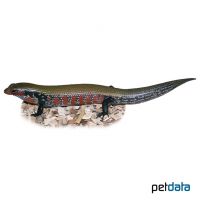Fire Skink (Lepidothyris fernandi)
| Fire Skink Lepidothyris fernandi | |
|---|---|
| Name | Fire Skink |
| Name Lat. | Lepidothyris fernandi |
| Synonym | Mochlus fernandi |
| Family | Skinks |
| Family lat. | Scincidae |
| Order | Scaled Reptiles |
| Order lat. | Squamata |
| Origin | Africa |
| Habitat | Forests |
| Diet | Insects, snails |
| Humidity | 70-80 % |
| Behavior | Semi-aggressive |
| Keeping | Individual, pair |
| Care Level | Moderate |
| Reproduction | Oviparous |
| Housing | Humid terrarium |
| Life Span | 5 years |
| Protection | No |
| Metric Units | |
| Size | 36 cm |
| Temperature | 25-28 °C |
| Temperature Local | 35 °C |
| Housing Size | 120 x 90 x 90 cm |
| US Units | |
| Size | 14" |
| Temperature | 77-82 °F |
| Temperature Local | 95 °F |
| Housing Size | 45" x 35" x 35" |
Distribution and habitat
The diurnal and crepuscular fire finches are widespread in West Africa, from Guinea to Nigeria to Angola. They live in the tropical rainforests in the foliage and under roots, where they dig burrows in the moist soil.
Maintenance
Minimum dimensions for the terrarium, according to the size and number of animals
| 1-2 animals | 5KRL x 4KRL x 4KRL (L x W x H) |
Head-torso length (KRL) is measured on the largest animal. For each additional animal, increase the footprint by 15%. A terrarium of e.g. 120 x 90 x 90 cm is recommended, which should be placed in a quiet and vibration-free place
They need a humid terrarium with flat climbing branches, stone structures (hiding places, visual protection) and structured back and side walls (e.g. cork covering) as well as a large water bowl for bathing and a 10-15 cm deep substrate for digging. Terrarium humus or a soil-peat mixture, covered with some foliage and bark mulch, as well as planting for decoration (ficus, ivy, etc.) is suitable. The substrate should always be kept slightly moist. Several times a day the inside of the terrarium should be finely sprayed with water. A rain or mist system is ideal
| Temp. day: 25-28 °C | Temp. night: 20-22 °C | Temp. local: up to 35 °C | Humidity: 70-80 |
Thermostatically controlled floor heating is recommended. Lighting duration must be 12-14 hrs, depending on the season. They need sunny places with radiant heat and daily UV irradiation.
Diet
The food supply consists of live insects, such as crickets, house crickets, small grasshoppers, cockroaches, mealybug larvae, etc., snails and earthworms, and occasionally, depending on the individual, sweet fruits (e.g. bananas, berries). After habituation, ready-made food for insectivorous reptiles is often accepted. Wax moths should rarely be fed in very small amounts because of their large fat content. It is important to add minerals and vitamins regularly (e.g. by dusting the feeders). Young animals should be offered food daily, adults 4-5 times a week. Drinking water must always be available
A regular and varied diet promotes health and prevents deficiency symptoms.
Reproduction and breeding
The males are larger and more magnificently colored than the females
They are oviparous and one clutch consists of 8-10 eggs. The incubation period is 55-60 days at a temperature of 26-28 °C. However, viviparous females have also been observed. Small insects such as fruit flies, aphids, micro echinoderms, etc. are suitable as initial food
Life expectancy can be 5 years.
Important
Both males and females are often intraspecific incompatible. It is often difficult to find a harmonious pair. Towards other species they often behave aggressively
The ground temperature of 20-24 °C should always be slightly lower than the air temperature. They need sunny places, e.g. climbing branches or stones irradiated with a spotlight.
The quality of the feeders can be upgraded by giving them fruit and honey water as food.
The terrarium must have good ventilation without drafts and meet the species specific needs. Measuring devices such as thermometers, hygrometers, etc. are necessary. The lighting has to correspond to the species-specific day-night rhythm and has to be placed in such a way that the animals cannot injure themselves. The terrarium should be locked in such a way that neither unauthorized persons can open it nor the animals can escape. Contamination must be removed regularly
Further literature can be found in your pet store.
References
Text: petdata; Image: petdata
Source: BMELV (1997): Tierschutzgutachten - Mindestanforderungen an die Haltung von Reptilien; ENGELMANN (2006): Tierschutzgutachten - Zootierhaltung - Tiere in menschlicher Obhut: Reptilien und Amphibien, Harri Deutsch Verlag
- Gemäß § 21 Abs. 5 Tierschutzgesetz idgF
